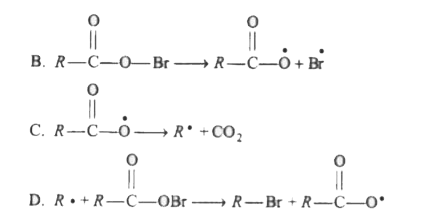Hunsdiecker reaction involve free radical in intermediate steps.
The correct Answer is:T
Step-by-Step Solution:
1. Understanding the Hunsdiecker Reaction:
The Hunsdiecker reaction is a chemical reaction that involves the conversion of carboxylic acids into alkyl halides. The general reaction can be represented as:
RCOOAg+Br2CCl4,reflux−−−−−−−→RBr+CO2+AgBr
2. Identifying the Role of Free Radicals:
In this reaction, we need to determine if free radicals are involved in the mechanism. Free radicals are species that have unpaired electrons and are highly reactive.
3. Initiation Step:
The reaction begins with the formation of a silver carboxylate complex. The carboxylic acid reacts with silver(I) ions to form the silver carboxylate:
RCOO−+Ag+→RCOOAg
4. Formation of Free Radicals:
The next step involves the reaction of the silver carboxylate with bromine (Br2). This step leads to the formation of a radical intermediate:
RCOOAg+Br2→RCOOBr+AgBr
Here, RCOOBr can undergo homolytic cleavage to form free radicals:
RCOOBr→RCOO⋅+Br⋅
5. Propagation Steps:
The free radical RCOO^\cdot can then decompose to form carbon dioxide and another radical:
RCOO⋅→R⋅+CO2
The alkyl radical (R^\cdot) can then react with bromine to form the final product:
R⋅+Br2→RBr+Br⋅
6. Conclusion:
The Hunsdiecker reaction indeed involves free radicals as intermediates in its mechanism. The presence of radical species during the reaction confirms that the statement about the involvement of free radicals is true.
---
The Hunsdiecker reaction is a chemical reaction that involves the conversion of carboxylic acids into alkyl halides. The general reaction can be represented as:
RCOOAg+Br2CCl4,reflux−−−−−−−→RBr+CO2+AgBr
In this reaction, we need to determine if free radicals are involved in the mechanism. Free radicals are species that have unpaired electrons and are highly reactive.
The reaction begins with the formation of a silver carboxylate complex. The carboxylic acid reacts with silver(I) ions to form the silver carboxylate:
RCOO−+Ag+→RCOOAg
The next step involves the reaction of the silver carboxylate with bromine (Br2). This step leads to the formation of a radical intermediate:
RCOOAg+Br2→RCOOBr+AgBr
Here, RCOOBr can undergo homolytic cleavage to form free radicals:
RCOOBr→RCOO⋅+Br⋅
The free radical RCOO^\cdot can then decompose to form carbon dioxide and another radical:
RCOO⋅→R⋅+CO2
The alkyl radical (R^\cdot) can then react with bromine to form the final product:
R⋅+Br2→RBr+Br⋅
The Hunsdiecker reaction indeed involves free radicals as intermediates in its mechanism. The presence of radical species during the reaction confirms that the statement about the involvement of free radicals is true.
Topper's Solved these Questions
Similar Questions
Knowledge Check
Which of the following reactions involve free radical as intermediate?
A B
B C
C D
D
Free radicals can undergo
Arearrangement to a more stable free radicalBdecomposition to give another free radicalCcombination with other free radicalDall are correctReaction involves isocyanate as intermediate product:
ACurtius rearrangementBLassen rearrangementCSchmidt rearrangementDHofmann rearrangement
The most stable free radical is
View SolutionThe Hunsdiecker reaction is believed to proceed by a free radical mechanism and involves the formation of an acyl hypohalite.


The rate determining step is :
View SolutionThe Hunsdiecker reaction is believed to proceed by a free radical mechanism and involves the formation of an acyl hypohalite.


The major product is :
View SolutionThe Hunsdiecker reaction is believed to proceed by a free radical mechanism and involves the formation of an acyl hypohalite.



View SolutionFormation of free radical is easiest in :
View Solution
